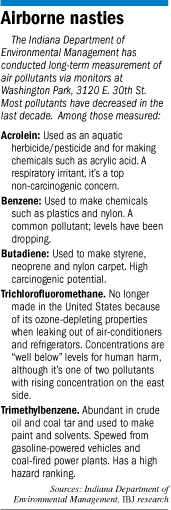Subscriber Benefit
As a subscriber you can listen to articles at work, in the car, or while you work out. Subscribe Now
 To the extent the masses are even cognizant of air pollution, their arch-villain would probably
To the extent the masses are even cognizant of air pollution, their arch-villain would probably
be “ground-level ozone.”
Most summers, the radio screams of “Knozone Action Days,” advising motorists to fuel after 6 p.m. and to avoid
idling at drive-ups. The idea is to reduce nitrogen oxides coming out of tailpipes and volatile organic compounds released
by fueling that, when baked in the sun, form ozone.
Ozone, along with fine particulates spewed by diesel engines and industry, can cause respiratory problems. Combined, the
two form smog, a brownish haze a la Los Angeles.
What gets less notice are airborne pollutants known as air toxics, a category of pollutant the state has made strides in
controlling.
The Indiana Department of Environmental Management recently completed a 10-year analysis of air toxics, including acrolein
and more recognizable hazards, such as benzene.
IDEM says in its newly released “ToxWatch” report that the level of air toxics over the last decade has “decreased
to within levels acceptable to the U.S. EPA.
“This trend in air toxics matches the overall decline in common air pollution concentrations across Indiana.”
The agency is quick to add that the results don’t represent overall air quality across the state—only at 10 air-monitoring
stations placed in areas of typically higher concentrations of air pollution.
In Indianapolis, the air toxics monitor is in Washington Park, at 3120 E. 30th St. It’s just north of the Martindale-Brightwood
community and northeast and downwind of the urban core.
The area has a smattering of existing and former manufacturing operations. Some of the heavy metals and volatile organic
chemicals from the area’s industrial heyday are subject to decay and evaporation into the air.
In general, air pollution concentrations “appear to be trending downwards” at the Washington Park monitor over
the last decade, IDEM stated in its report.
Of 24 pollutants it monitors there, 14 showed a decreasing trend, eight showed no discernable trend, and two—forms
of trichlorofluoromethane—were on the upswing.
Scott Deloney, chief of the programs branch of IDEM’s Office of Air Quality, sees the decline in air toxics levels
over a decade as linked to an overall decline in smog-creating pollutants in the state.
Indiana recently met all of the EPA’s so-called health-based air standards for smog for the first time since the standards
were enacted in the 1970s. There are no comparable standards or formal caps for air toxics, but there are benchmarks the federal
government uses to assess levels of toxics.
Deloney noted a number of new standards in recent years that have reduced tailpipe emissions, such as eliminating sulfur
in gasoline and diesel fuel in the mid-2000s.
One chemical linked to vehicle emissions did spike at Washington Park—acrolein.
It’s not classified as a carcinogen, but acrolein can cause respiratory problems and burning eyes. IDEM doesn’t
know what the long-term trend of acrolein emissions has been, though, because it just started measuring it in 2006.
Despite recent declines in key pollutants, more needs to be done in the region, particularly in places like Martindale-Brightwood,
said Jodi Perras, executive director of locally based not-for-profit Improving Kids’ Environment.
She pointed to studies by the Marion County Health Department showing disproportionately high hospitalization rates for Martindale-Brightwood
residents for ailments including asthma and chronic bronchitis.
Perras said efforts to expand the region’s public transit options and to encourage carpooling could go a long way toward
achieving additional air improvements.
Some of the improvements measured by IDEM over the last decade could be traced to the city’s industrial decline. For
example, Citizens Energy Group shuttered its century-old coke plant operation on the city’s southeast side about three
years ago. The plant had been a source of benzene emissions.•
Please enable JavaScript to view this content.
